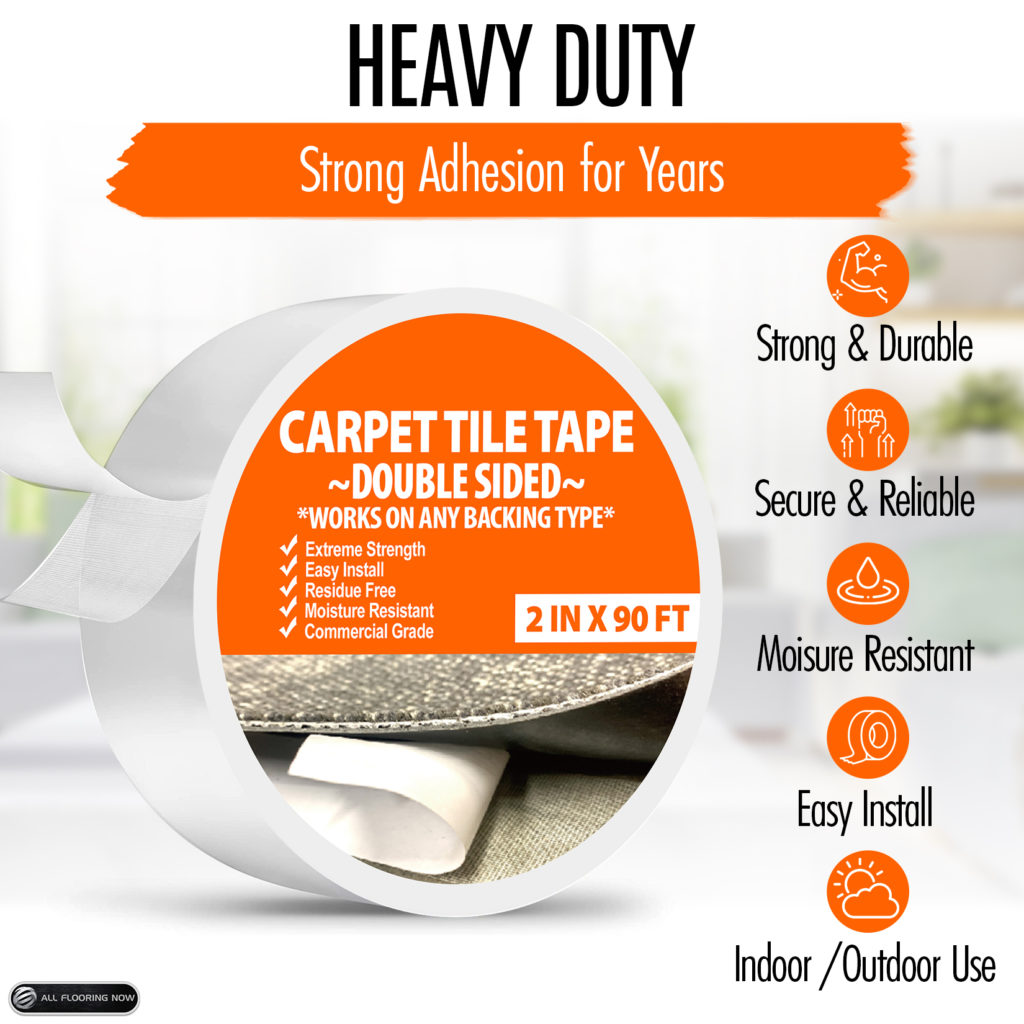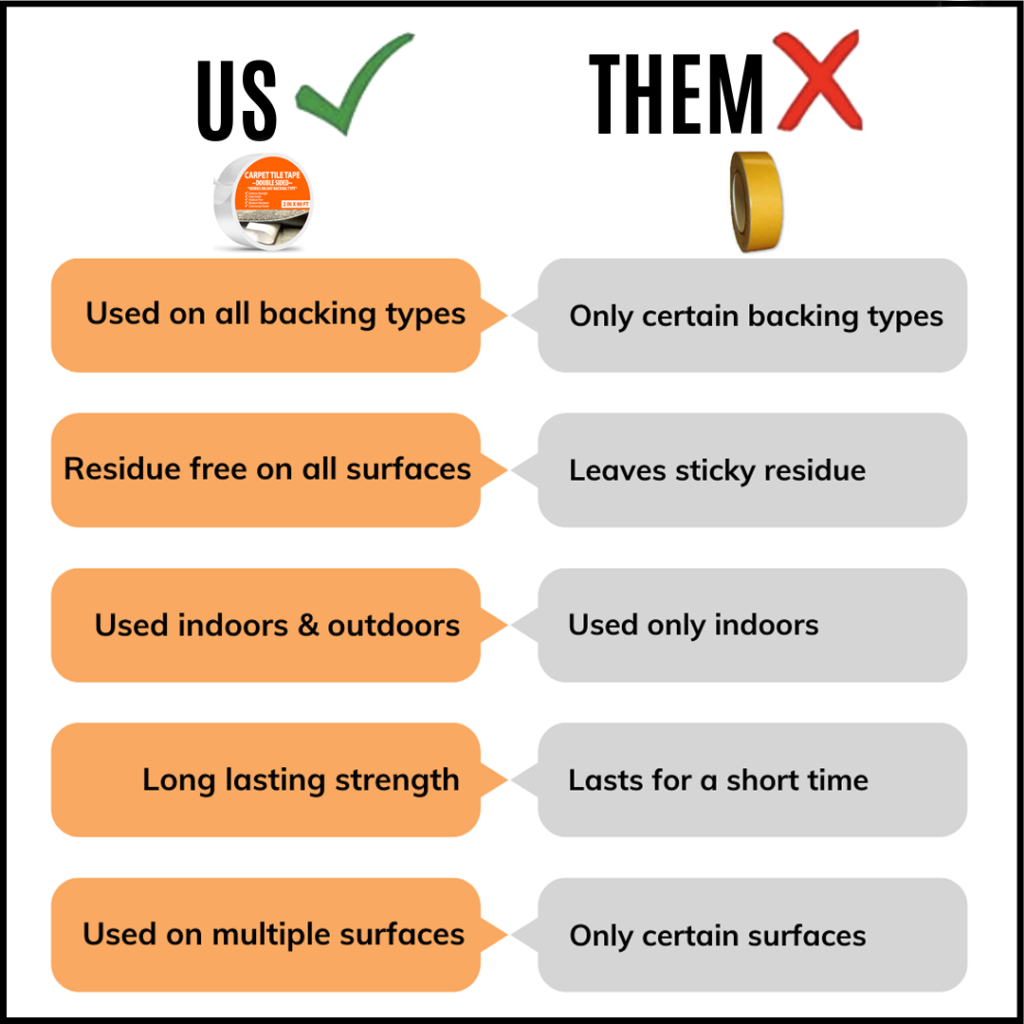Do Carpet Tiles Need To Be Glued Down?
The short answer is no.
One of the key decisions to make when installing carpet tiles is how to secure them to the floor. There are a few different methods, and understanding each one will help you determine whether you need to glue down your carpet tiles or use an alternative approach.
Carpet Tile Tape Double Sided
Double-sided carpet tile tape has revolutionized the installation process, offering a cleaner, faster, and more flexible alternative to traditional adhesives. Here's why it's become the preferred choice for many installers and property owners:
1. Easy Application
Carpet tile tape is incredibly easy to use. Simply cut the tape to size, peel off the backing, and apply it to the back of the carpet tile or directly to the floor. This process is much faster and cleaner than spreading liquid adhesive.
2. Immediate Use
Unlike liquid adhesives that require curing time, carpet tiles installed with double-sided tape can be walked on immediately after installation. This minimizes downtime, which is especially crucial in commercial settings.
3. Flexibility for Replacement
One of the biggest advantages of using carpet tile tape is the ease of replacing individual tiles. If a tile becomes damaged or stained, it can be easily lifted and replaced without disturbing the surrounding tiles. This is particularly beneficial in high-traffic areas or rental properties where frequent updates may be necessary.
4. No Damage to Subfloors
Carpet tile tape typically doesn't leave residue or cause damage to subfloors when tiles are removed. This makes it an excellent choice for temporary installations or in spaces where flooring changes might be frequent.
5. Versatility
High-quality carpet tile tape works well on various subfloor materials, including concrete, wood, and existing flooring. This versatility makes it suitable for a wide range of applications.
6. Cost-Effective
While the initial cost of carpet tile tape might be slightly higher than some adhesives, the long-term cost benefits are significant. Faster installation times mean lower labor costs, and the ability to easily replace individual tiles extends the life of the entire flooring system.
Best Practices for Using Carpet Tile Tape
To get the most out of carpet tile tape, follow these best practices:
- Ensure the subfloor is clean, dry, and level before installation
- Use a high-quality, heavy-duty carpet tile tape designed for your specific application
- Apply pressure to ensure good contact between the tape, tile, and floor
- Follow the manufacturer's guidelines for temperature and humidity during installation
Pressure Sensitive Adhesive Glue Down Method
The glue-down method involves using a carpet adhesive to attach the tiles directly to the subfloor. This method is often used in commercial and high-traffic environments where long-term durability is critical. There are two primary types of adhesive used for carpet tiles:
- Full Adhesive Application: In this method, glue is spread across the entire subfloor before laying the carpet tiles. This creates a strong bond between the floor and the tile, ensuring that the carpet remains securely in place even under heavy use. It’s commonly used in office buildings, retail spaces, and other high-traffic areas.
- Perimeter Gluing: This method involves applying glue only around the perimeter of the carpeted area or in strategic spots rather than the entire surface. It provides some degree of stability without the permanence of full adhesive application, making it easier to remove or replace tiles in the future.
Advantages of Glue Down
- Stability: Glued-down carpet tiles won’t move or shift over time, which is especially important in areas with high foot traffic or where heavy furniture is placed.
- Long-Lasting: Once glued down, the installation is more likely to withstand wear and tear over a long period.
- Prevents Curling: Carpet tiles can sometimes curl at the edges, especially if they’re subjected to moisture or heavy use. Gluing them down helps prevent this issue.
- Professional Appearance: A glue-down installation provides a sleek, smooth appearance without gaps or uneven seams.
Disadvantages of Gluing Down Carpet Tiles
- Difficult Removal: Once glued, removing carpet tiles can be challenging. The adhesive may leave residue on the subfloor, which requires additional work to clean up, making it harder to replace tiles or switch to a different type of flooring later.
- Higher Cost: The glue-down method can be more expensive due to the additional cost of adhesive and professional installation services.
- Time-Consuming Installation: Applying adhesive and waiting for it to dry adds extra time to the installation process.
The Peel-and-Stick Method
Some carpet tiles come with a pre-applied adhesive backing, commonly referred to as peel-and-stick tiles. With this method, you simply peel off the protective layer and stick the tile to the subfloor. This eliminates the need for additional adhesive and makes the installation process much quicker.
Advantages of Peel-and-Stick Carpet Tiles
- Ease of Installation: The peel-and-stick method is one of the easiest ways to install carpet tiles. You don’t need special tools or expertise, and the adhesive is already applied, saving time and effort.
- Removable: Peel-and-stick carpet tiles can be removed and replaced more easily than those glued down with traditional adhesive. This makes them a good option for spaces where you anticipate needing to replace individual tiles.
- Cost-Effective: Since you won’t need to buy additional adhesive, peel-and-stick tiles can be more budget-friendly.
Disadvantages of Peel-and-Stick Carpet Tiles
- Less Durable: While convenient, peel-and-stick tiles may not offer the same long-term durability as glued-down tiles, especially in high-traffic areas.
- Adhesive Failure: The pre-applied adhesive can weaken over time, particularly in environments with fluctuating temperatures or moisture. This can lead to tiles shifting or coming loose.
- Limited Design Options: Not all carpet tile styles and materials are available in a peel-and-stick format, limiting your choices.
The Floating Installation Method
In a floating installation, the carpet tiles are not glued down at all. Instead, they are laid on top of a smooth subfloor and held in place by their own weight or by using carpet tile tape (a double-sided adhesive tape applied to the edges or corners of the tiles). This method is popular for DIY installations and spaces where flexibility and ease of removal are important.
Advantages of Floating Carpet Tile Installation
- No Adhesive Required: The absence of adhesive makes this method cleaner and easier to manage.
- Flexibility: Floating carpet tiles can be easily removed, rearranged, or replaced without damaging the subfloor.
- Ideal for Temporary Installations: If you’re installing carpet tiles in a space that may change or where you want the option to remove them in the future, a floating installation is an excellent choice.
Disadvantages of Floating Carpet Tile Installation
- Less Stability: Without adhesive, floating tiles are more prone to shifting, especially in high-traffic areas. Furniture or heavy foot traffic can cause the tiles to move out of alignment.
- Increased Wear: Because the tiles are not as securely fastened, they may wear more quickly or develop gaps between them over time.
- Not Suitable for All Spaces: Floating installations may not be the best choice in areas with heavy use, moisture, or extreme temperature fluctuations.
Which Method Is Right for You?
The decision of whether to glue down your carpet tiles depends on several factors, including the space, traffic levels, budget, and how permanent you want the installation to be.
- Carpet Tile Tape Double Sided Installation: Perfect for temporary or low-traffic areas, and for those looking for a flexible solution that can be easily removed.
- Glued-Down Carpet Tiles: Best for high-traffic areas, commercial spaces, or any place where long-term durability is a priority.
- Peel-and-Stick Tiles: Ideal for DIY projects and residential spaces where ease of installation and removal is more important than heavy-duty performance.
- Floating Installation: Perfect for temporary or low-traffic areas, and for those looking for a flexible solution that can be easily modified or removed.
Conclusion
Carpet tiles offer a range of installation options, from full adhesive applications to floating installations using carpet tile tape. While gluing down carpet tiles provides the most stability and long-term durability, it also requires more effort and cost upfront. Peel-and-stick tiles offer a middle ground, making installation easier, but they may not be as durable in high-traffic areas. The floating method offers flexibility but is best suited for low-traffic or temporary installations. By understanding the pros and cons of each method, you can choose the best option for your specific needs, ensuring a successful and lasting carpet tile installation.





